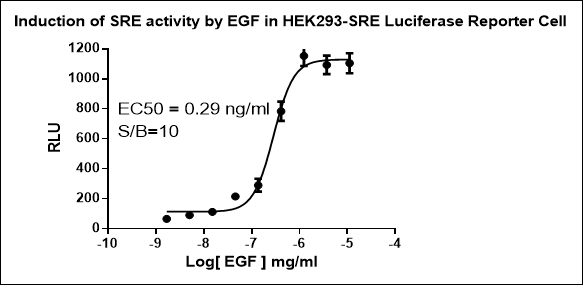

| RQP74030 | |
| I. Background | |
| The MAPK/ERK signaling pathway is a major participant in the regulation of cell growth and differentiation. It can be activated by various extracellular stimuli including mitogens, growth factors, and cytokines. Upon stimulation, MEK1/2 phosphorylate and activate ERK1/2. The activated ERK translocates to the nucleus where it phosphorylates and activates transcription factors. The TCFs (Ternary Complex Factors), including Elk1, are among the best-characterized transcription factor substrates of ERK. When phosphorylated by ERK, Elk1 forms a complex with Serum Response Factor (SRF) and binds to Serum Response Element (SRE), resulting in the expression of numerous mitogen-inducible genes. | |
| II. Description | |
| The SRE Reporter- HEK293 cell line is designed for monitoring the activity of the MAPK/ERK signaling pathway. The SRE Reporter-HEK293 cell line contains a firefly luciferase gene under the control of SRE responsive elements stably integrated into HEK293 cells, resulting in an ERK pathway-responsive reporter cell line. | |
| III. Introduction | |
| Host Cell: | HEK293 |
| Expressed gene: | SRE-Luciferase |
| Stability: | 32 passages |
| Synonym(s): | SRE cell line, MAPK reporter, ERK reporter |
| Freeze Medium: | 90% FBS+10% DMSO |
| Culture Medium: | DMEM+10%FBS+200ug/ml hygromycin |
| Mycoplasma Testing: | Negative |
| Storage: | Liquid nitrogen |
| Application(s): | · Monitor MAPK/ERK signaling pathway activity and SRF-mediated activity. · Screen for activators or inhibitors of the MAPK/ERK signaling pathway. |
| IV. Description of Host Cell Line | |
| Organism: | Homo sapiens, human |
| Tissue: | Embryonic kidney |
| Disease: | Normal |
| Morphology: | Epitheloid cell |
| Growth Properties: | Adherent |
| Ⅴ. Representative Data | |
 | |
Figure 1. Detect Luciferase assay by Promega Bright-Glo Luciferase Assay System. HEK293/SRE Luciferase Reporter cells were stimulated by EGF, the S/B was 10-fold. | |